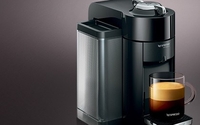 The idea of some of the new connected devices in The
Internet of Things seems to be to make life for people a little easier.
The idea of some of the new connected devices in The
Internet of Things seems to be to make life for people a little easier.
At the very least, some look to provide fingertip access to do something without having to get up.
In essence,
many are looking to further integrate the physical and digital worlds.
The latest example is the new Nespresso coffeemaker that lets you start the brewing from a mobile app, so you don’t
have to leave the chair or bed. Of course, that presumes you pre-loaded the capsule before sitting down or hitting the hay.
The latest approach by Mozilla is to create a technology platform so
that you could issue into a device such commands as ‘turn off the lights downstairs.’
At CES earlier this year, Chinese TV maker Hisense showed me their version of smart home
appliance integration. While watching TV, a message is sent to the TV letting you know that the washing machine cycle just ended.
There are many more such examples, but you get the idea.
The irony here is that there are somewhat competing forces in the industry.
The wearables industry is providing for millions of consumers fitness trackers, with software primarily aimed at
helping people move more.
Meanwhile, some IoT appliances makers are creating connected home devices aimed at helping people move less.
The people who plan to buy wearables in the
foreseeable future are pretty high tech and very much attuned to style, as detailed in an insightful IDC study I wrote about here just yesterday (Wearable Buyers: 89% Comfortable With Technology, 74% See It As Exciting).
Of course, the appliance activity is mostly information, at least at the moment. For example, you still have to physically go to the coffeemaker to get the coffee and to the washing machine to
empty it of the clean clothes, which you had to physically put in at the start.
End game, of course, is for the appliances to actually do things for you. This has already started, such as a
washing machine self-ordering supplies or a printer self-ordering ink, when a cartridge is running low.
Before that approach is fully cooked sometime down the road, more devices hitting the
market will promote consumers sitting while a machine takes care of something for them.
The Fitbit and Jawbone wearers are likely to go do it manually, for the credit.
The fitness
tracker doesn’t need the rest.